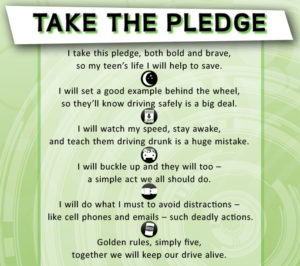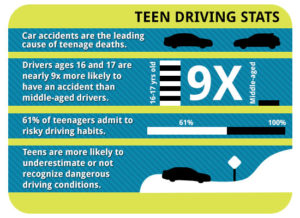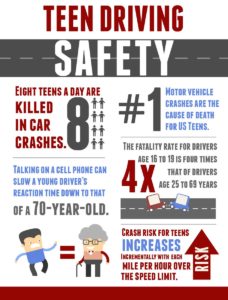Teen Driving Facts & Statistics – May 2019
Educating Teen Drivers

As a parent we worry about our teen driving and it’s our job to educate them on the rules and laws of safe driving. Before your teen hits the road set these “5 to Drive” rules.
- No Cell phones while driving
- No extra passengers
- No speeding
- No alcohol
- No driving or riding without a seat belt
Continue to practice driving with your teen even after they obtain their drivers license. The more you practice driving with your teen the more experience they will have behind the wheel and will reduce the likelihood of an accident. The reason there are so many accidents with teen drivers is due to inexperience driving. Teen drivers struggle with judging gaps in traffic, driving the right speed for conditions and turning safely, among other things.
Facts
- In 2016 there were 2,433 teens ranging in age between 16-19 that were killed. There were 292,742 teens treated in emergency departments for injuries suffered in a motor vehicle crash.
- Motor vehicle crashes are the leading cause of death for U.S. teens? Every day 1 in 8 teens ranging in ages 16 – 19 are killed in a motor vehicle accident.
- Teen drivers between the ages of 16 to 19 are more likely to be in a fatal crash compared to 20 and older adult.
- 16-year-olds have higher crash rates than drivers of any other age.
- Half of all teens will be involved in a car accident before they graduate high school.
- 56% of teens have said they talk on the phone while driving. Talking on a cell phone can double the likelihood of an accident as well as slow the teen’s reaction time down to that of a 70-year-old.
- 53% of teen deaths occur from auto crashes between Friday and Saturday and weekend prime time. Teen crash fatalities occur between 9 a.m. an 12 a.m. in general.
- 32% of teen driver fatalities is contributed to speeding.
- 20% of fatal car crashes involving teenager’s alcohol was a factor.
- 47% of teen driver killed in car accident weren’t wearing a seat belt.
- Statistics show that 16 and 17-year old driver death rates increase with each additional passenger.
- 1 in 5 of 16- year old drivers will have an accident within their first year of driving.
- 16- to 17-year old drivers are nine times more likely to be involved in a crash than adults and six times more likely to be involved in a fatal crash than adults.
What can we do as a parent?
- Set a good example. Your behavior is greatly influenced by your teen when it comes to driving. Practice safe driving habits yourself, especially when your teen is in the car with you. Refrain from talking on the cell phone, speeding, disobeying traffic signs and unsafe driving behaviors. Set the example for your teen when it comes to driving. What message do you want to send your teen?
- Talk to your teen about the driving risks. Share statistics regarding teenage driving fatalities and the risk factors that contribute to them. Talk to your teen about the danger of drug and alcohol use while driving under the influence and tell them it’s against the law. Let your teen know the impact and ramifications it will have on them.
- Continue to practice driving with your teen. Your teen passed their permit and road test. This does not mean they are an experienced driver. Parents should continue to practice safe driving with their teen. This is a great way to spend time together while helping them improve on their driving skills.


